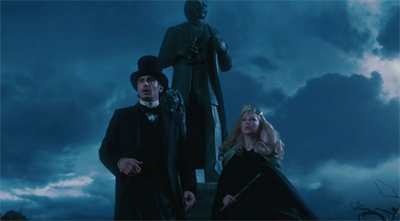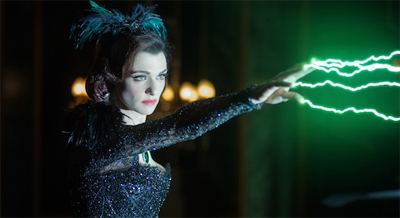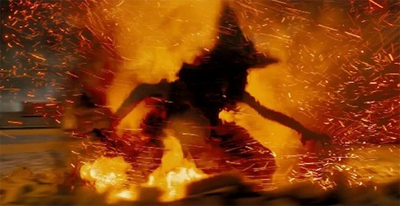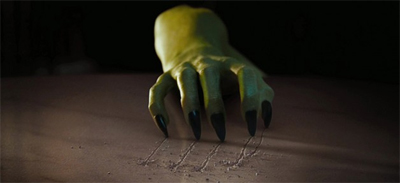I quite enjoyed Oz: The Great & Powerful. The visuals were amazing, and I thought that Sam Raimi brought the world of Oz to life in a way that audiences haven’t really seen since 1939. Despite the fact that the film was limited to elements from the source novels rather than the classic film, meaning no red slippers and the Winkie Guards chanting a generic “ho-ho-ho” instead of “ho-ee-ho-ee-oh”, I think that Oz: The Great & Powerful is the first time that a film has taken us back to that version of the wonderful world of Oz.
It’s a shame, then, about the script. I have a lot of problems with the screenplay by Mitchell Kapner and David Lindsay-Abaire. Indeed, I’m less than thrilled that Kapner has apparently been tapped by Disney to prepare a sequel. While Raimi and his cast, and his production designers, seem to understand a great deal about the magic of The Wizard of Oz, it seems like Kapner and Lindsay-Abaire seem to have missed the point.
It’s a shame, then, that Oz: The Great & Powerful rolled on March 8th, celebrated as International Women’s Day. Dorothy Gale has been described as “the first feminist role model” and The Wizard of Oz is packed to the brim with strong female characters. Although Dorothy obviously can’t play a major role in this prequel, one does wonder where all the strong women have gone.
Note: This post contains spoilers for Oz: The Great & Powerful. Consider yourself warned.
The men in The Wizard of Oz are all kinda crap. I mean, Dorothy’s three travelling companions are sweet – but they are a bit useless in the grand scheme of things. It’s Dorothy who really leads the characters on their trip across the land of Oz, and her male supporting cast just sort of tag along beside her. Outside of the Scarecrow, the Tin Man and the Cowardly Lion, the men of Oz don’t seem especially helpful or useful on Dorothy’s quest to get home. When Dorothy finally manages to find the eponymous Wizard, she discovers he’s just a huckster who talks a relatively good game, but does relatively little to get him home.
In contrast, the female characters are far more proactive. Granted, Glinda could probably have been a bit more helpful earlier in the story. It might have been nice to know that Dorothy could get home before engaging in all that risky stuff. Still, it is Glinda rather than the Wizard who tells Dorothy how she can return to Kansas. And Glinda does intervene directly in the story, which is more than could be said for the Wizard himself, who is really just a conman hiding behind a curtain.
And then there’s the Wicked Witch. To be fair, Wicked has done a fantastic job fleshing out the background and motivations for the green-skinned sorceress, but even in The Wizard of Oz it is clear that the Wicked Witch is a very major political force in the land of Oz. Everybody is terrified of her, she holds a large amount of power and she marches to her own drumbeat. She’s evil, but she’s portrayed as her own character with her own motivations.
The Wicked Witch is out to get Dorothy because Dorothy landed a house on her sister. It’s not exactly a situation that most of us can empathise with (though it does sound like a Jerry Springer episode waiting to happen – “get your house off my sister!”), but it is solid as character motivation goes. She has her own agency, and she’s shown to be efficient in carrying out her own plans. To be honest, without the convenient handicap of melting when exposed to water, I reckon her chances of succeeding were quite high.
So that’s The Wizard of Oz, in a nutshell. It was packed with strong female characters in 1939. You would imagine that – over seventy years later – that sort of portrayal of women wouldn’t be so remarkable. You would hope that this sort of thing is now commonplace, that stories centred around female characters are a lot more frequent. And, to a certain extent, they are.
While the number of actresses who can headline a major tentpole release is relatively small, interest in franchises like The Host and The Hunger Games are demonstrating that films featuring strong female characters can do well. The problem is that these sorts of films have only really emerged in the past couple of years, and are still very much in the minority. But that is a discussion for another time.
However, it’s a shame that Oz: The Great & Powerful represents such a massive step backwards for the portrayal of all these characters. Okay, some of these changes were necessary by virtue of the premise. If you are making a prequel about the Wizard coming to Oz, then he needs to be the driving force of the story. And, to be fair, it is very hard to reconcile the charming and heroic version of Oz who appears at the end of Oz: The Great & Powerful to the cheesy conman at the end of The Wizard of Oz, but that is a structural problem. You can’t have the character end his heroic journey as that sort of huckster.
The problem, however, is how Oz is portrayed. It seems like the land of Oz is just waiting for the Wizard to arrive. The story features three major female characters, but it seems like none of them have really been doing that much before Oz falls to Oz. Sure, the king has been murdered and Glinda is exiled as a murderer. However, nothing too dynamic seems to be happening. The throne sits unoccupied. It seems that none of the female characters are doing anything but waiting for the prophesied male character to appear so that they can begin reacting to him.
There are three witches in Oz: The Great & Powerful. Glinda is the Good Witch, the one who tends to appear all over pop culture inside a bubble. She played the role of Dorothy’s advisor in The Wizard of Oz, and very occasionally intervened to help – and, of course, was responsible for getting Dorothy home. Here, however, she’s much more of a cheerleader for Oz. She assembles an army of tinkerers, farmers and munchkins to re-take the kingdom. When Oz hesitates, she tries to encourage him. “The only person you have fooled is yourself,” she assures him.
All of this begs the question of why Glinda needs Oz. Why can’t she act on her own accord? She does most of the hard work. She recruits the army. Oz’s technical genius might save the day, but it’s very hard to understand why Glinda is happy to simply stand by and watch her sister lay siege to the land of Oz while she waits. We see the Chinatown massacre, but it seems unlikely that this was the first such atrocity. So the implication is that Glinda simply sits by and watches all this, waiting for a big strong wizard to arrive and save the world.
It doesn’t help that Glinda spends the climax tied up and held hostage, as emotional leverage over Oz himself. This reduces Glinda to the role of the stereotypical love interest. She spends the early part of the film assuring the male lead that his capable of more than he thinks, and then gets captured to serve as additional motivation for his heroism at the climax of the tale. It really feels like a waste, turning Glinda into a more marginal figure than she was in The Wizard of Oz, and taking away a great deal of her own agency and power.
There are two wicked witches in Oz: The Great & Powerful. The script decides to play with the audience’s expectations here. We know that one of these two will become the green-skinned Wicked Witch with an allergy to water, and we know that another is destined to death by falling house. The movie tries a little bit of misdirection, to try to confuse us about which fate awaits Theodora and Evanora. It’s a concept that could be quite clever, but fails due to the poor workmanship of the script.
In order to make the twist work, we need to be invested in at least one of the characters. We need to care so much about at least of one of the witches that the revelation hits like a sucker punch. Quite simply, Oz: The Great & Powerful doesn’t develop either of the two characters enough for us to care which one turns out to be evil. The plotline featuring Evanora and Theodora feels like a shallow afterthought, composed of the worst sorts of clichés.
Let’s start with Evanora, who manages to be the strongest female character in the film, while still being woefully underdeveloped and a little bit sexist. She is the red herring. She has a house coming her way in the not-too-distant future. However, the film tries to mislead us into suspecting she will be the green one. After all, Evanora is clad mostly in green. She’s introduced as sinister and plotting. She’s shown controlling an army of flying monkeys. Her name almost sounds like “Evil.” These associations are designed to link her with the Wicked Witch.
And, had Evanora turned out to be the Wicked Witch, Oz: The Great & Powerful might seem a great deal less sexist. We don’t get much insight into Evanora. Why is she evil? Given she killed her father to take control of Oz, how come she hasn’t claimed the throne? There’s a sense that there’s a great deal missing here. Is it possible that the Emerald City is a male-dominated society, one that must have a king and will not tolerate a queen? Does the death of the King of Oz mean that none of his three daughters could succeed him?
That sort of institutional sexism really should be raised. It would go a long way towards making the witches more complex characters. Is Evanora simply reacting against that sort of sexism? Is her anger justified, even if her flying baboons seem a little smash-happy? Okay, we’d be straying a little close to an awkward portrayal of straw feminism, but it would make a great deal more sense (and be a great deal less offensive) than the ultimate motivation of the Wicked Witch.
Unfortunately, Evanora is just a blank slate. She’s evil because… well, she’s evil. She doesn’t even get the same sort of basic motivation that the Wicked Witch received in The Wizard of Oz. There’s no reason for her to murder her father – especially since it seems like it would never have landed her the throne anyway. Still, Rachel Weisz is solid enough in the role that Evanora is the strongest female character in the film, even if she’s still much weaker than any of the major female characters in The Wizard of Oz.
With Theodora, however, we run into the biggest problems. You see, Theodora is the Wicked Witch. It’s a twist! A surprise! A plot point out of nowhere! She’s introduced as a nice character. She is a romantic interest for Oz. She wears red, rather than green. She doesn’t know that Evanora is the Wicked Witch. She doesn’t even know that witches should ride broomsticks. All this effort is almost counter-effective. We suspect Theodora simply because it would make the best twist.
And so Theodora is the Wicked Witch. How? Because she’s a jilted lover! Remember how I remarked how great it was that the Wicked Witch was independent and she wasn’t defined by any of the male characters in Oz? Well, that’s all nonsense now. Turns out that she hooked up with Oz, turned into a super-clingy girlfriend, and then thought that Oz was cheating on her! But he wasn’t, but who cares, because women be craaaazy! Am I right?
It is, quite frankly, lazy plotting and sexist nonsense. The Wicked Witch is a great villain, and Oz: The Great & Powerful turns her into a jealous lover. Evanora lies to Theodora, suggesting that Oz “danced” with her in her chambers. She then shows footage of Oz acting all friendly to Glinda, because – you know – female characters only really exist so Oz can mark notches on his bed post. To be fair, I think anybody would be a little upset.
However, it’s notable that Theodora doesn’t try to talk to Oz about this. She doesn’t try to see his side of the story. That’s grand. After all, Evanora is her sister. So you’d assume the proportionate response would be to simply kick that cheating douchebag to the curb. Send him a little note explaining the situation, if you can’t bring yourself to talk to him like an adult. Instead, Theodora becomes a green-skinned rage monster who threatens genocide in Oz because her man may have cheated on her. Because women be craaaazy! Am I right?
This is offensive on so many levels. Nevermind what it does to Theodora as a character in this story. Nevermind what it does tot he Wicked Witch’s character in The Wizard of Oz. Nevermind that it reduces the psychological complexity of the lead female character in a prequel to one of the most feminist family of films of all time to a variation on “women be craaaazy!” It’s just bad writing, and it smacks of a writing team who have no idea how to write female characters.
Oz: The Great & Powerful opened on International Women’s Day, and it serves as a warning about how shallow and how sexist pop culture can be. It’s all the more puzzling because of the esteem generated by The Wizard of Oz as an early feminist children’s story filled with strong female characters. Wicked also did a fantastic job hitting on these themes.
Instead, Oz: The Great & Powerful is a catalogue of sexist clichés. Glinda exists to motivate our male hero and to rescued by him. Evanora is a back-stabbing psychopath with no motivation. Theodora is a psychotic ex-girlfriend. I really expected so much more.
Filed under: Movies | Tagged: Cowardly Lion, David Lindsay-Abaire, dorothy, Dorothy Gale, Gilda, Glinda the Good Witch, Great Comet, James Franco, L. Frank Baum, mila kunis, Mitchell Kapner, oz: the great & powerful, rachel weisz, sam raimi, Wicked Witch of the West, Wizard of Oz |
































Nice points! It’s a movie that isn’t perfect, but definitely left me entertained. Everybody seems to love Wicked a lot more though.
Yep, I am very much looking forward to seeing Wicked when it comes to Dublin later in the year. And I didn’t hate the film – I just thought it had a terrible script. The execution of that script was generally fantastic.
Also upsetting to me was that the characters’ physical looks “showed the workd” their goodness and evil. Glinda was blond and pretty and good. Theodora’s inner evil turned her into an ugly green witch with scary nails. Evanora’s inner evil was shown to the world when she turned ugly and — gasp — old. Grey hair and wrinkles. Yikes!
I agree to an extent, Liz, but the original Wizard of Oz did play into those stereotypes as well. The good witch look like a prom queen, and the Wicked Witch was green. It’s a common fairytale trope, even if I wish that it was something that people thought a bit about before applying so liberally.
Well i am definitely not watching it now! Haha I’ll be waiting till DVD 😀
Being honest, this is just my reaction to the film. And I think it was visually stunning and beautifully put together. Being honest, if you are going to watch it, I would recommend watching it in the cinema. The design and the production is really lavish. I just really hated the script.
Not my thing and £8.20 will not be leaving my wallet for this 😀
Fair point. 🙂
Besides, there’s a busy season ahead!
Damn straight! 😀
As opposed to unleashing your inner Gloria Steinem, consider “The Prophecy” as mentioned in the film.
Hi Wyatt. Well, to be fair, “the prophecy” isn’t any more or less inherently sexist than any other plot device used by the writers. It’s just something the writers use to tell their story or move the plot along or justify their creative decisions. After all, the prophecy doesn’t exist unless the writers want it to.
And the writers thought it would be best to have all the female characters just sitting on their hands waiting for a man to show up and sort this mess out for them. They just justified that by creating the prophecy.
And, besides, surely any leader worth their salt would try to sort out Oz’s (or their) problems before the prophesized wizard got there, turning it into a sort of a fait accompli? If I were Evanora, I’d feel more comfortable confronting this wizard if I’d killed Glinda already – after all, I know exactly where she is. Hell, I’d claim the thrown as an interim measure and wait for the wizard to turn up, and secure my power base. I wouldn’t pace the room and wait for the first handsome stranger to drape himself over the furniture. If I were Glinda, I’d probably be working on retaking the Emerald City so that the Wizard’s arrival is just icing on the cake. Sitting there idly waiting for a promised saviour to magically make everything better is completely pointless, if you aren’t willing to try yourself.
If they’d had a prophecy about a jilted lover turning green with envy, it wouldn’t change the fact that Theodora’s character arc is one of the most trite and sexist villainous arcs in recent memory.
Also the prophecy is never actually explained in the movie. Characters mention it for plot purposes, but none ever give any actual details on what this prophecy is, why anyone actually believes it or why it’s important. It is only described in the most general terms. It is just a lazy plot device to excuse why every one is so fixated on an otherwise useless person.
Yep. Exactly.
From what I’ve read, just from surface level internet research so not to say this is 100% correct, but it seems that Glinda is the kings only real daughter and Evanora is his advisor and Theodora is Evanora’s sister. So that being said that is why she couldn’t just take the throne after she killed him, however, since Glinda is banished because Evanora convinced everyone she killed the king it doesn’t make sense that she wouldn’t take the throne, maybe to still seem like a protagonist. Because after all the king has already told everyone the prophecy of the wizard of Oz coming to Oz and it seems as if Evanora is more of a “power hungry step on anyone in her way” kind of evil rather than just plain evil but still wants to be viewed as good maybe for the love of her sister? Maybe for the love of the people of the city? Who knows. And as for her being independent and strong in the prequel but not in The Wizard of Oz, at the end of Oz the Great and Powerful when her necklace is taken she turns old and I believe it also weakens her powers which I think may have something to do with it. My third piece is about the comment of Theodora not being mature and speaking with him and it is meant to come off as a “women be crazy” sort of thing from the writers I don’t think she ever really had a chance to be mature and speak with him. Of course she had her melt down but I think anyone man or woman after hearing such news would be pretty upset and may need a minute to get that out of their system before “being mature” and having the conversation with Oz but she doesn’t get to because her sister poisons her and at that point she wouldn’t care enough to talk to him because she has no heart she only feels hate, spite, and revenge. To me this doesn’t come off as anti-feminist (you do make points however about other anti-feminist ideas in the movie but that’s another thing) she didn’t choose to become a green-skinned rage monster that was the doing of her sister. However, that leads me into one of my bigger issues with the scripting of this prequel, Glinda seems to be about second chance and believing in the good in people and by the end so does Oz when he states that if she finds good in her she can come back, and maybe he doesn’t know that it was Evanora’s doing, but then in The Wizard of Oz he and Glinda send Dorothy on a man-hunt to kill Theodora, The wicked witch of the west, instead of trying to get her heart back of change her. So this prequel gives us a tragic backstory of a naive, heart broken girl who is turned evil and stripped of any good inside of her by her own sister and then given no redemption AT ALL in The Wizard of Oz!! I mean come on all of the antagonist are supposed to be “good people” who believe in second chances and all that and then she is killed for something that wasn’t even her own doing. It just doesn’t match up. Speaking of redemption this also leads me to my last point, at the end of Oz the Great and Powerful Oz is seen to have earned redemption for the cheap con-man he was back in Kansas, he saves Oz and becomes a hero just for him to turn around right back to his old self in The Wizard of Oz. Overall there were a few comments I wanted to make about this initial post and a few of my own comments I wanted to make but for the most part I completely agree and I too think the script was just lazy in relations to The Wizard of Oz and definitely could’ve been better. Don’t get me wrong it was a good movie, I’ve seen it multiple times and I enjoy watching it every time but if it’s supposed to be a prequel to The Wizard of Oz make it make sense.